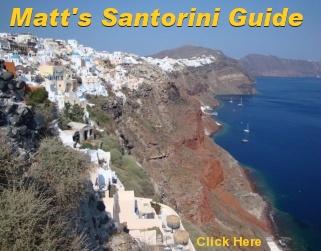|
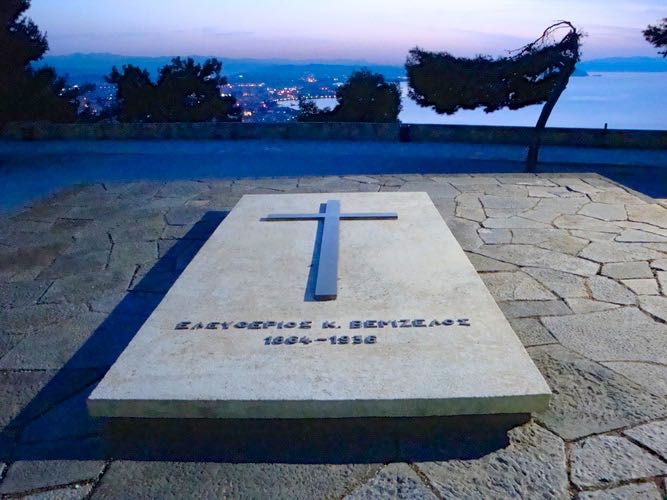 For those with a car you must visit the Akrotiri Peninsula which separates the city of Chania from Souda Bay where the ferry comes in. By following signs in Chania to the airport you will come to the Venizelos Graves where he and his son Sophocles Venizelos, another
Prime Minister
of Greece are buried. In a spot chosen before hand by Venizelos himself as his final resting place, his body was brought here from Paris, where he spent his last years in self-imposed exile. At the time he was such
a polarising figure they bypassed Athens because they were afraid there would be riots. Venizelos chose a beautiful spot. You have a view of the entire city of Chania and all the way down the coast to the Rodopou Peninsula as well as the White Mountains to the south of the city. Though it pales when compared to his many accomplishments, such as the unification of the land we now call Greece, education and social services, his choice of Profitis Ilias as a grave site has meant that thousands, millions of people
have come up to enjoy the beauty and the view of this special area, shaded by pine trees and in the winter at least, a place of peaceful reflection. In the summer I imagine it must get its share of tour buses who also visit the beautiful church of Profitti Ilias. Beyond the gravesite is the Koukouvia Cafe, a popular student hangout and a great place to go for a coffee with an incredible view. For those with a car you must visit the Akrotiri Peninsula which separates the city of Chania from Souda Bay where the ferry comes in. By following signs in Chania to the airport you will come to the Venizelos Graves where he and his son Sophocles Venizelos, another
Prime Minister
of Greece are buried. In a spot chosen before hand by Venizelos himself as his final resting place, his body was brought here from Paris, where he spent his last years in self-imposed exile. At the time he was such
a polarising figure they bypassed Athens because they were afraid there would be riots. Venizelos chose a beautiful spot. You have a view of the entire city of Chania and all the way down the coast to the Rodopou Peninsula as well as the White Mountains to the south of the city. Though it pales when compared to his many accomplishments, such as the unification of the land we now call Greece, education and social services, his choice of Profitis Ilias as a grave site has meant that thousands, millions of people
have come up to enjoy the beauty and the view of this special area, shaded by pine trees and in the winter at least, a place of peaceful reflection. In the summer I imagine it must get its share of tour buses who also visit the beautiful church of Profitti Ilias. Beyond the gravesite is the Koukouvia Cafe, a popular student hangout and a great place to go for a coffee with an incredible view.
|
|
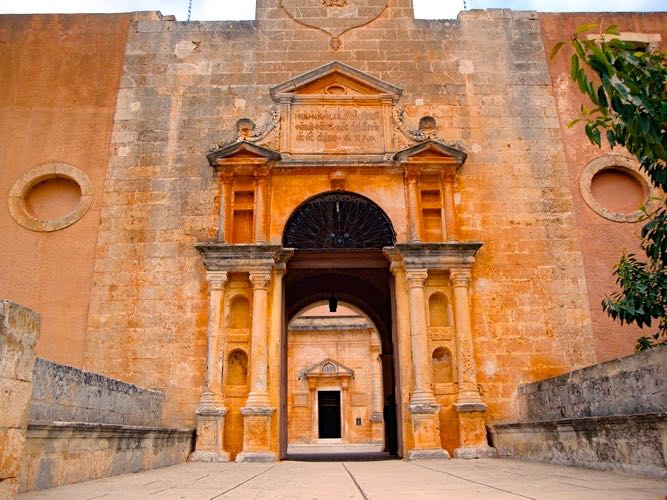 For those continuing on by car to explore the Akrotiri Peninsula whose southern end is like a suburb of Chania though it is actually many different towns that have become unified by sprawl, there are a number of places that must be visited. First and foremost is the Monastery of Agia Triada,
established
in 1612, one of the most beautiful in Greece and one of the wealthiest with miles and miles of olive trees and grapes all meticulously cared for as only monks and people who are fanatics about order can do. If you drive around the area you can see the difference between the olive trees that belong to the monastery and those that belong to the local farmers. Inside the walls of the monastery it is a photographers dream come true though you
can't take photos in the church itself. If you arrive after 2pm you may not see a soul. The monastery has a shop and sells some of the produce from its fields but if you arrive late in the afternoon it may not be open either so try to visit here in the morning, maybe on your way to the beaches of Akrotiri. For those continuing on by car to explore the Akrotiri Peninsula whose southern end is like a suburb of Chania though it is actually many different towns that have become unified by sprawl, there are a number of places that must be visited. First and foremost is the Monastery of Agia Triada,
established
in 1612, one of the most beautiful in Greece and one of the wealthiest with miles and miles of olive trees and grapes all meticulously cared for as only monks and people who are fanatics about order can do. If you drive around the area you can see the difference between the olive trees that belong to the monastery and those that belong to the local farmers. Inside the walls of the monastery it is a photographers dream come true though you
can't take photos in the church itself. If you arrive after 2pm you may not see a soul. The monastery has a shop and sells some of the produce from its fields but if you arrive late in the afternoon it may not be open either so try to visit here in the morning, maybe on your way to the beaches of Akrotiri.
|
|
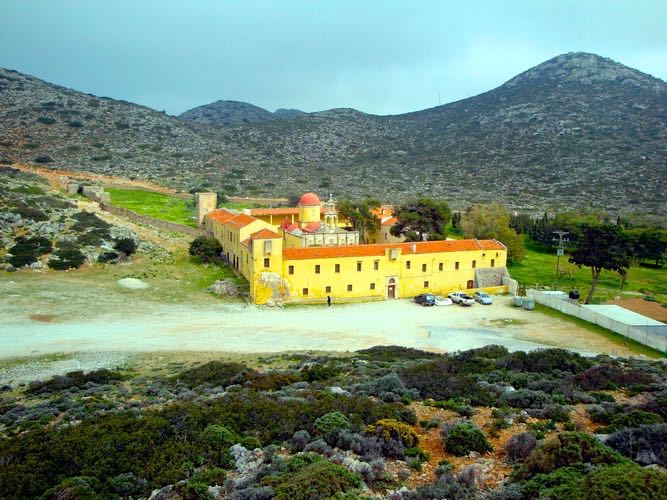 Further on through the olive groves and up a narrow road that winds through a pass in the mountains you come to Gouvernetou Monastery on the edge of the sea, it too with beautiful fields of olives and tall pine trees. North of the monastery on a small path
through a
ravine is the abandoned Monastery of Saint John the Hermit, also known
as the Katholiko which may have been the first monastery built in Crete perhaps as early as the 6th Century. Nearby is the cave where the saint lived and died with impressive stalactites and stalagmites, a view of the sea and a reservoir of water which is believed to have healing properties. Akrotiri is also known for its many caves, some quite impressive. Besides the previously mentioned Cave of Saint John the Hermit there is the Arkoudospilia (Cave of the Bear) which is a few minutes
walk
from Gouvernetou Monastery, with a church at the entrance and a giant bear shaped rock in the center where many 5th century artifacts have been found, most likely left there as offerings to whatever God people believed lived there. Koumarospilios is 4 kilometers east of Agia Triada and is
known for its colorful stalagmites and stalactites (as are most caves). Achirospilios is also near Katholiko and has large columns, while Nerospilia northwest of the village of Chordaki, as the name implies has beautiful designs formed by the water that drips through the cave's ceiling. Neraidospilia is northeast of Mount Skloka and Leros Cave on Mount Stavros is named for a Cretan chieftain who hid here while fighting the Turks. Further on through the olive groves and up a narrow road that winds through a pass in the mountains you come to Gouvernetou Monastery on the edge of the sea, it too with beautiful fields of olives and tall pine trees. North of the monastery on a small path
through a
ravine is the abandoned Monastery of Saint John the Hermit, also known
as the Katholiko which may have been the first monastery built in Crete perhaps as early as the 6th Century. Nearby is the cave where the saint lived and died with impressive stalactites and stalagmites, a view of the sea and a reservoir of water which is believed to have healing properties. Akrotiri is also known for its many caves, some quite impressive. Besides the previously mentioned Cave of Saint John the Hermit there is the Arkoudospilia (Cave of the Bear) which is a few minutes
walk
from Gouvernetou Monastery, with a church at the entrance and a giant bear shaped rock in the center where many 5th century artifacts have been found, most likely left there as offerings to whatever God people believed lived there. Koumarospilios is 4 kilometers east of Agia Triada and is
known for its colorful stalagmites and stalactites (as are most caves). Achirospilios is also near Katholiko and has large columns, while Nerospilia northwest of the village of Chordaki, as the name implies has beautiful designs formed by the water that drips through the cave's ceiling. Neraidospilia is northeast of Mount Skloka and Leros Cave on Mount Stavros is named for a Cretan chieftain who hid here while fighting the Turks.
|
|
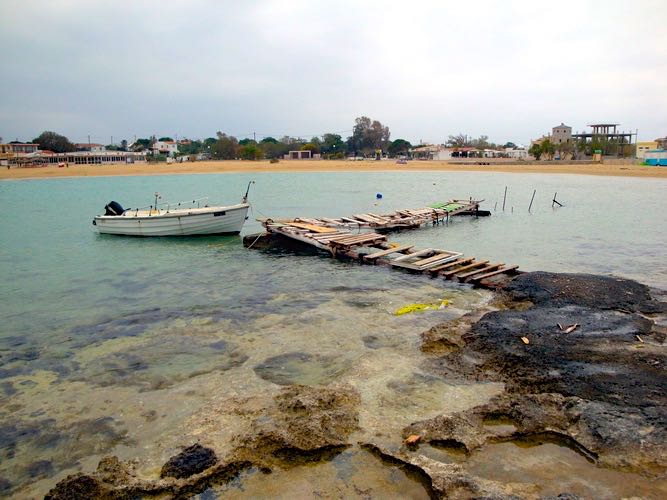 If you have children there is a waterpark near Stavros beach and if there are nature lovers in your ensemble there is a wildlife sanctuary at Macherida Lake near the beach village of Tersanas. For those not ready to tackle the Samarian Gorge there is a smaller gorge that begins on
the beach and
goes up to the village of Kabani. If you continue towards the village of Chorafakia and follow the signs to the beach of Stavros you will find yourself in perhaps one of the most historically and culturally significant beaches in all of Greece
if not the world. This is where Zorba the Greek, with Anthony Quinn and Alan Bates was filmed and though development has certainly changed it over the years, it is a must for any fan of the film. You can even eat at Zorbas Taverna. Just follow the signs. The beach is popular with day-trippers from Chania and there are also a large number of summer and weekend houses and small rooms to rent. There are also beaches at Kalathas, Tersanas, on the west coast and Marathi and Loutraki on
the east coast of Akrotiri. But true Zorba fans would not think of swimming anywhere but Stavros. If you are planning to stay in this area, which is a good idea since the beaches are beautiful and you are still within easy striking distance of Chania, contact Fantasy Travel and ask about hotels in western Crete or see Matt's Hotels of Greece Crete Pages If you have children there is a waterpark near Stavros beach and if there are nature lovers in your ensemble there is a wildlife sanctuary at Macherida Lake near the beach village of Tersanas. For those not ready to tackle the Samarian Gorge there is a smaller gorge that begins on
the beach and
goes up to the village of Kabani. If you continue towards the village of Chorafakia and follow the signs to the beach of Stavros you will find yourself in perhaps one of the most historically and culturally significant beaches in all of Greece
if not the world. This is where Zorba the Greek, with Anthony Quinn and Alan Bates was filmed and though development has certainly changed it over the years, it is a must for any fan of the film. You can even eat at Zorbas Taverna. Just follow the signs. The beach is popular with day-trippers from Chania and there are also a large number of summer and weekend houses and small rooms to rent. There are also beaches at Kalathas, Tersanas, on the west coast and Marathi and Loutraki on
the east coast of Akrotiri. But true Zorba fans would not think of swimming anywhere but Stavros. If you are planning to stay in this area, which is a good idea since the beaches are beautiful and you are still within easy striking distance of Chania, contact Fantasy Travel and ask about hotels in western Crete or see Matt's Hotels of Greece Crete Pages
|
|
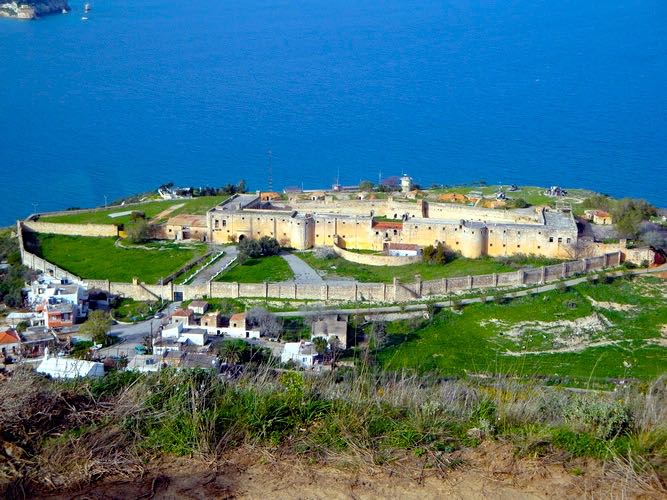 In the center of the Akrotiri Peninsula on a high plane is the Chania Airport. To the east is Souda Bay, protected by the Venetian Fortress of Agios Nicholaos on the small island of Souda, the last stronghold of the Venetians who finally surrendered to the Turks in 1722
half a century
after the rest of the island had fallen. Across the bay near the village of Kalami is the Fortress of Itzedin, built in 1646 though enlarged by the Turks during the Cretan rebellion in 1866. It was
later turned into a prison. The bay has been of strategic importance since Venetian times, maybe earlier and is still today, with Greek Military and NATO bases and signs that warn you not to take photographs. Below the village of Sternes, directly across from the island of Souda is the ancient port of Minoa named for the Minoan ruins found nearby. It was a port of the ancient city of Aptera across the bay. Just before you get to the port of Souda is the Allied Cemetery where 1,527 soldiers who fought
in the Battle of Crete are buried. Most are
British, followed by New Zealanders and Australians. Interestingly there are also the graves of three German's who were buried here by mistake, one because he happened to be wearing a British watch and was thus misidentified. Because many of the remains of these soldiers were moved here from other places where they were buried soon after the fighting their exact identities are unknown. In the center of the Akrotiri Peninsula on a high plane is the Chania Airport. To the east is Souda Bay, protected by the Venetian Fortress of Agios Nicholaos on the small island of Souda, the last stronghold of the Venetians who finally surrendered to the Turks in 1722
half a century
after the rest of the island had fallen. Across the bay near the village of Kalami is the Fortress of Itzedin, built in 1646 though enlarged by the Turks during the Cretan rebellion in 1866. It was
later turned into a prison. The bay has been of strategic importance since Venetian times, maybe earlier and is still today, with Greek Military and NATO bases and signs that warn you not to take photographs. Below the village of Sternes, directly across from the island of Souda is the ancient port of Minoa named for the Minoan ruins found nearby. It was a port of the ancient city of Aptera across the bay. Just before you get to the port of Souda is the Allied Cemetery where 1,527 soldiers who fought
in the Battle of Crete are buried. Most are
British, followed by New Zealanders and Australians. Interestingly there are also the graves of three German's who were buried here by mistake, one because he happened to be wearing a British watch and was thus misidentified. Because many of the remains of these soldiers were moved here from other places where they were buried soon after the fighting their exact identities are unknown.
Though it looks harmless enough it does not take the imagination of a schoolboy to wonder what goes on in the unseen places in a natural harbor that is not merely the best in Crete, but maybe in all the Mediterranean. The port of Souda is where the daily ferry comes in and the small town that has sprung up around the giant grain towers is full of cafe-bars, souvlakia shops and psistarias as well as several ticket offices for the ferry boats. Since most ferries
leave
at 9pm for the overnight trip to
Pireaus its not a bad place to have a last dinner on the island, rather than eat the food on the ship. The giant towers you see in the port are not hiding rockets, but are actually used to store grain.
|
|
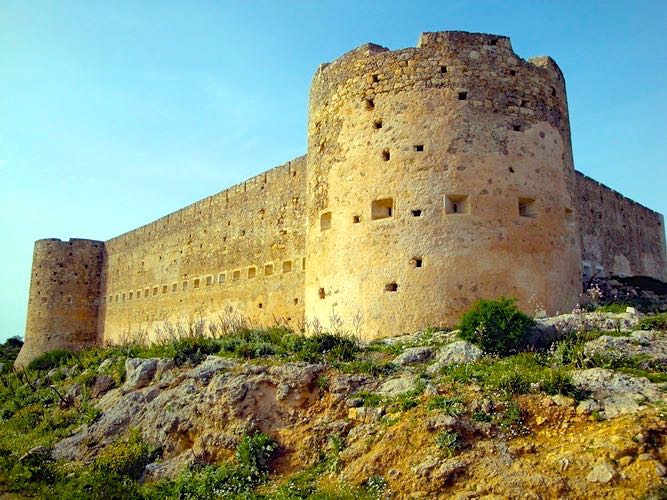 For those not quite ready to head back to Chania you can continue east on the National Road and stop in Kalami to get a better view of the Itzedin Fortress or follow the signs for Ancient Aptera near the village of Megala Horafi. Aptera was an important Minoan city founded
somewhere around
the 7th century BC that had been completely destroyed by the Arabs in 823 and disappeared completely from the map until discovered by Robert Pashley in 1834 while randomly digging in the area when he uncovered
coins minted by the city. Those who are not archaeologists may not be too impressed but there are Roman cisterns that are in surprisingly good condition and the whole site is surrounded by olive groves. At the entrance to the site is the Monastery of Saint John built by the Venetians. Underneath, archaeologists have discovered an earlier Christian church and some graves. Below Aptera is a massive Turkish fortress, sign-less as are many Turkish fortresses in Greece. Nonetheless it has an impressive view of Itzedin
Fortress and no signs saying no photos. For those not quite ready to head back to Chania you can continue east on the National Road and stop in Kalami to get a better view of the Itzedin Fortress or follow the signs for Ancient Aptera near the village of Megala Horafi. Aptera was an important Minoan city founded
somewhere around
the 7th century BC that had been completely destroyed by the Arabs in 823 and disappeared completely from the map until discovered by Robert Pashley in 1834 while randomly digging in the area when he uncovered
coins minted by the city. Those who are not archaeologists may not be too impressed but there are Roman cisterns that are in surprisingly good condition and the whole site is surrounded by olive groves. At the entrance to the site is the Monastery of Saint John built by the Venetians. Underneath, archaeologists have discovered an earlier Christian church and some graves. Below Aptera is a massive Turkish fortress, sign-less as are many Turkish fortresses in Greece. Nonetheless it has an impressive view of Itzedin
Fortress and no signs saying no photos.
|
|
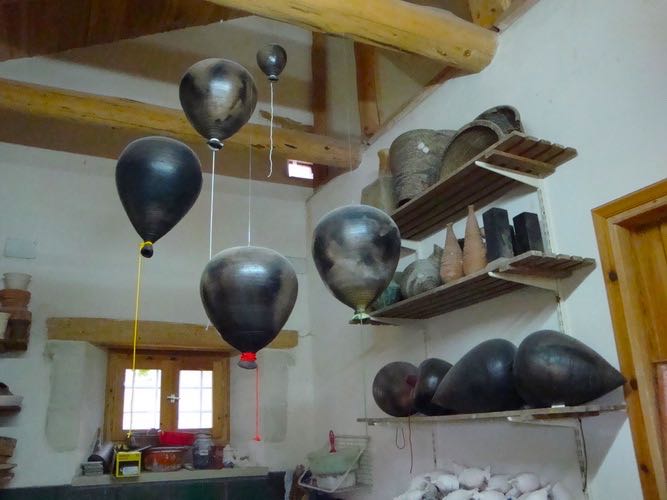 The area of Apokoronas is full of farmland watered by rivers and streams which come down from the Lefka Ori (White Mountains) as is much of the coastal area around Chania. The town of Vrisses on the road to Sfakia has a river, the Vryssanos, running right
through
the center and cafes on each side. The village of Georgioupoli on the coast at the mouth of this same river is a popular resort area and is known for its sandy beach and the eucalyptus trees which grow along the river bank. To the north is the ancient city of Amfimalla and to the south is Lake Kournas, the only natural lake on Crete and a haven for all sorts of wild birds and freshwater fish including eels which used to be abundant. It is believed that somewhere in the vicinity of the
lake was a Temple to Athena but if so it has yet to be discovered. The town of Vamos is the center of the prefecture, largely agricultural as are the rest of the surrounding villages which like many of those inland have escaped the ravages of tourism. If you want to see what Cretan village life is like take a day and explore them by car, stopping wherever suits your fancy for coffee and a meal. In the small town of Paidohori on a hill in a location so remote that you probably won't find it on your own
is the workshop of one of Greece's most renown ceramic artists, Manousos Chalkiadakis. Though window-shoppers are not encouraged to stop in since it is a working studio, serious art lovers can phone him at 28250 71181 and arrange for a visit. His work can also be found in the Tzamia Krystalla Gallery of Santorini as well as in the gift shop of the Hotel Ammos. Guests of the hotel can
also make arrangements with the desk to visit the workshop. The area of Apokoronas is full of farmland watered by rivers and streams which come down from the Lefka Ori (White Mountains) as is much of the coastal area around Chania. The town of Vrisses on the road to Sfakia has a river, the Vryssanos, running right
through
the center and cafes on each side. The village of Georgioupoli on the coast at the mouth of this same river is a popular resort area and is known for its sandy beach and the eucalyptus trees which grow along the river bank. To the north is the ancient city of Amfimalla and to the south is Lake Kournas, the only natural lake on Crete and a haven for all sorts of wild birds and freshwater fish including eels which used to be abundant. It is believed that somewhere in the vicinity of the
lake was a Temple to Athena but if so it has yet to be discovered. The town of Vamos is the center of the prefecture, largely agricultural as are the rest of the surrounding villages which like many of those inland have escaped the ravages of tourism. If you want to see what Cretan village life is like take a day and explore them by car, stopping wherever suits your fancy for coffee and a meal. In the small town of Paidohori on a hill in a location so remote that you probably won't find it on your own
is the workshop of one of Greece's most renown ceramic artists, Manousos Chalkiadakis. Though window-shoppers are not encouraged to stop in since it is a working studio, serious art lovers can phone him at 28250 71181 and arrange for a visit. His work can also be found in the Tzamia Krystalla Gallery of Santorini as well as in the gift shop of the Hotel Ammos. Guests of the hotel can
also make arrangements with the desk to visit the workshop.
You can do this itinerary from Chania with Dimitris the Taxi Driver if you don't want to rent a car.
If you are planning to stay in this area, which is a good idea since the beaches are beautiful and you are still within easy striking distance of Chania, contact Fantasy Travel and ask about hotels in western Crete or see Matt's Hotels of Greece Crete Pages
|
|

 For those with a car you must visit the Akrotiri Peninsula which separates the city of Chania from Souda Bay where the ferry comes in. By following signs in Chania to the airport you will come to the Venizelos Graves where he and his son Sophocles Venizelos, another
Prime Minister
of Greece are buried. In a spot chosen before hand by Venizelos himself as his final resting place, his body was brought here from Paris, where he spent his last years in self-imposed exile. At the time he was such
a polarising figure they bypassed Athens because they were afraid there would be riots. Venizelos chose a beautiful spot. You have a view of the entire city of Chania and all the way down the coast to the Rodopou Peninsula as well as the White Mountains to the south of the city. Though it pales when compared to his many accomplishments, such as the unification of the land we now call Greece, education and social services, his choice of Profitis Ilias as a grave site has meant that thousands, millions of people
have come up to enjoy the beauty and the view of this special area, shaded by pine trees and in the winter at least, a place of peaceful reflection. In the summer I imagine it must get its share of tour buses who also visit the beautiful church of Profitti Ilias. Beyond the gravesite is the Koukouvia Cafe, a popular student hangout and a great place to go for a coffee with an incredible view.
For those with a car you must visit the Akrotiri Peninsula which separates the city of Chania from Souda Bay where the ferry comes in. By following signs in Chania to the airport you will come to the Venizelos Graves where he and his son Sophocles Venizelos, another
Prime Minister
of Greece are buried. In a spot chosen before hand by Venizelos himself as his final resting place, his body was brought here from Paris, where he spent his last years in self-imposed exile. At the time he was such
a polarising figure they bypassed Athens because they were afraid there would be riots. Venizelos chose a beautiful spot. You have a view of the entire city of Chania and all the way down the coast to the Rodopou Peninsula as well as the White Mountains to the south of the city. Though it pales when compared to his many accomplishments, such as the unification of the land we now call Greece, education and social services, his choice of Profitis Ilias as a grave site has meant that thousands, millions of people
have come up to enjoy the beauty and the view of this special area, shaded by pine trees and in the winter at least, a place of peaceful reflection. In the summer I imagine it must get its share of tour buses who also visit the beautiful church of Profitti Ilias. Beyond the gravesite is the Koukouvia Cafe, a popular student hangout and a great place to go for a coffee with an incredible view. For those continuing on by car to explore the Akrotiri Peninsula whose southern end is like a suburb of Chania though it is actually many different towns that have become unified by sprawl, there are a number of places that must be visited. First and foremost is the Monastery of Agia Triada,
established
in 1612, one of the most beautiful in Greece and one of the wealthiest with miles and miles of olive trees and grapes all meticulously cared for as only monks and people who are fanatics about order can do. If you drive around the area you can see the difference between the olive trees that belong to the monastery and those that belong to the local farmers. Inside the walls of the monastery it is a photographers dream come true though you
can't take photos in the church itself. If you arrive after 2pm you may not see a soul. The monastery has a shop and sells some of the produce from its fields but if you arrive late in the afternoon it may not be open either so try to visit here in the morning, maybe on your way to the beaches of Akrotiri.
For those continuing on by car to explore the Akrotiri Peninsula whose southern end is like a suburb of Chania though it is actually many different towns that have become unified by sprawl, there are a number of places that must be visited. First and foremost is the Monastery of Agia Triada,
established
in 1612, one of the most beautiful in Greece and one of the wealthiest with miles and miles of olive trees and grapes all meticulously cared for as only monks and people who are fanatics about order can do. If you drive around the area you can see the difference between the olive trees that belong to the monastery and those that belong to the local farmers. Inside the walls of the monastery it is a photographers dream come true though you
can't take photos in the church itself. If you arrive after 2pm you may not see a soul. The monastery has a shop and sells some of the produce from its fields but if you arrive late in the afternoon it may not be open either so try to visit here in the morning, maybe on your way to the beaches of Akrotiri.  Further on through the olive groves and up a narrow road that winds through a pass in the mountains you come to Gouvernetou Monastery on the edge of the sea, it too with beautiful fields of olives and tall pine trees. North of the monastery on a small path
through a
ravine is the abandoned Monastery of Saint John the Hermit, also known
as the Katholiko which may have been the first monastery built in Crete perhaps as early as the 6th Century. Nearby is the cave where the saint lived and died with impressive stalactites and stalagmites, a view of the sea and a reservoir of water which is believed to have healing properties. Akrotiri is also known for its many caves, some quite impressive. Besides the previously mentioned Cave of Saint John the Hermit there is the Arkoudospilia (Cave of the Bear) which is a few minutes
walk
from Gouvernetou Monastery, with a church at the entrance and a giant bear shaped rock in the center where many 5th century artifacts have been found, most likely left there as offerings to whatever God people believed lived there. Koumarospilios is 4 kilometers east of Agia Triada and is
known for its colorful stalagmites and stalactites (as are most caves). Achirospilios is also near Katholiko and has large columns, while Nerospilia northwest of the village of Chordaki, as the name implies has beautiful designs formed by the water that drips through the cave's ceiling. Neraidospilia is northeast of Mount Skloka and Leros Cave on Mount Stavros is named for a Cretan chieftain who hid here while fighting the Turks.
Further on through the olive groves and up a narrow road that winds through a pass in the mountains you come to Gouvernetou Monastery on the edge of the sea, it too with beautiful fields of olives and tall pine trees. North of the monastery on a small path
through a
ravine is the abandoned Monastery of Saint John the Hermit, also known
as the Katholiko which may have been the first monastery built in Crete perhaps as early as the 6th Century. Nearby is the cave where the saint lived and died with impressive stalactites and stalagmites, a view of the sea and a reservoir of water which is believed to have healing properties. Akrotiri is also known for its many caves, some quite impressive. Besides the previously mentioned Cave of Saint John the Hermit there is the Arkoudospilia (Cave of the Bear) which is a few minutes
walk
from Gouvernetou Monastery, with a church at the entrance and a giant bear shaped rock in the center where many 5th century artifacts have been found, most likely left there as offerings to whatever God people believed lived there. Koumarospilios is 4 kilometers east of Agia Triada and is
known for its colorful stalagmites and stalactites (as are most caves). Achirospilios is also near Katholiko and has large columns, while Nerospilia northwest of the village of Chordaki, as the name implies has beautiful designs formed by the water that drips through the cave's ceiling. Neraidospilia is northeast of Mount Skloka and Leros Cave on Mount Stavros is named for a Cretan chieftain who hid here while fighting the Turks.  If you have children there is a waterpark near Stavros beach and if there are nature lovers in your ensemble there is a wildlife sanctuary at Macherida Lake near the beach village of Tersanas. For those not ready to tackle the Samarian Gorge there is a smaller gorge that begins on
the beach and
goes up to the village of Kabani. If you continue towards the village of Chorafakia and follow the signs to the beach of Stavros you will find yourself in perhaps one of the most historically and culturally significant beaches in all of Greece
if not the world. This is where Zorba the Greek, with Anthony Quinn and Alan Bates was filmed and though development has certainly changed it over the years, it is a must for any fan of the film. You can even eat at Zorbas Taverna. Just follow the signs. The beach is popular with day-trippers from Chania and there are also a large number of summer and weekend houses and small rooms to rent. There are also beaches at Kalathas, Tersanas, on the west coast and Marathi and Loutraki on
the east coast of Akrotiri. But true Zorba fans would not think of swimming anywhere but Stavros. If you are planning to stay in this area, which is a good idea since the beaches are beautiful and you are still within easy striking distance of Chania,
If you have children there is a waterpark near Stavros beach and if there are nature lovers in your ensemble there is a wildlife sanctuary at Macherida Lake near the beach village of Tersanas. For those not ready to tackle the Samarian Gorge there is a smaller gorge that begins on
the beach and
goes up to the village of Kabani. If you continue towards the village of Chorafakia and follow the signs to the beach of Stavros you will find yourself in perhaps one of the most historically and culturally significant beaches in all of Greece
if not the world. This is where Zorba the Greek, with Anthony Quinn and Alan Bates was filmed and though development has certainly changed it over the years, it is a must for any fan of the film. You can even eat at Zorbas Taverna. Just follow the signs. The beach is popular with day-trippers from Chania and there are also a large number of summer and weekend houses and small rooms to rent. There are also beaches at Kalathas, Tersanas, on the west coast and Marathi and Loutraki on
the east coast of Akrotiri. But true Zorba fans would not think of swimming anywhere but Stavros. If you are planning to stay in this area, which is a good idea since the beaches are beautiful and you are still within easy striking distance of Chania,  In the center of the Akrotiri Peninsula on a high plane is the Chania Airport. To the east is Souda Bay, protected by the Venetian Fortress of Agios Nicholaos on the small island of Souda, the last stronghold of the Venetians who finally surrendered to the Turks in 1722
half a century
after the rest of the island had fallen. Across the bay near the village of Kalami is the Fortress of Itzedin, built in 1646 though enlarged by the Turks during the Cretan rebellion in 1866. It was
later turned into a prison. The bay has been of strategic importance since Venetian times, maybe earlier and is still today, with Greek Military and NATO bases and signs that warn you not to take photographs. Below the village of Sternes, directly across from the island of Souda is the ancient port of Minoa named for the Minoan ruins found nearby. It was a port of the ancient city of Aptera across the bay. Just before you get to the port of Souda is the Allied Cemetery where 1,527 soldiers who fought
in the Battle of Crete are buried. Most are
British, followed by New Zealanders and Australians. Interestingly there are also the graves of three German's who were buried here by mistake, one because he happened to be wearing a British watch and was thus misidentified. Because many of the remains of these soldiers were moved here from other places where they were buried soon after the fighting their exact identities are unknown.
In the center of the Akrotiri Peninsula on a high plane is the Chania Airport. To the east is Souda Bay, protected by the Venetian Fortress of Agios Nicholaos on the small island of Souda, the last stronghold of the Venetians who finally surrendered to the Turks in 1722
half a century
after the rest of the island had fallen. Across the bay near the village of Kalami is the Fortress of Itzedin, built in 1646 though enlarged by the Turks during the Cretan rebellion in 1866. It was
later turned into a prison. The bay has been of strategic importance since Venetian times, maybe earlier and is still today, with Greek Military and NATO bases and signs that warn you not to take photographs. Below the village of Sternes, directly across from the island of Souda is the ancient port of Minoa named for the Minoan ruins found nearby. It was a port of the ancient city of Aptera across the bay. Just before you get to the port of Souda is the Allied Cemetery where 1,527 soldiers who fought
in the Battle of Crete are buried. Most are
British, followed by New Zealanders and Australians. Interestingly there are also the graves of three German's who were buried here by mistake, one because he happened to be wearing a British watch and was thus misidentified. Because many of the remains of these soldiers were moved here from other places where they were buried soon after the fighting their exact identities are unknown.  For those not quite ready to head back to Chania you can continue east on the National Road and stop in Kalami to get a better view of the Itzedin Fortress or follow the signs for Ancient Aptera near the village of Megala Horafi. Aptera was an important Minoan city founded
somewhere around
the 7th century BC that had been completely destroyed by the Arabs in 823 and disappeared completely from the map until discovered by Robert Pashley in 1834 while randomly digging in the area when he uncovered
coins minted by the city. Those who are not archaeologists may not be too impressed but there are Roman cisterns that are in surprisingly good condition and the whole site is surrounded by olive groves. At the entrance to the site is the Monastery of Saint John built by the Venetians. Underneath, archaeologists have discovered an earlier Christian church and some graves. Below Aptera is a massive Turkish fortress, sign-less as are many Turkish fortresses in Greece. Nonetheless it has an impressive view of Itzedin
Fortress and no signs saying no photos.
For those not quite ready to head back to Chania you can continue east on the National Road and stop in Kalami to get a better view of the Itzedin Fortress or follow the signs for Ancient Aptera near the village of Megala Horafi. Aptera was an important Minoan city founded
somewhere around
the 7th century BC that had been completely destroyed by the Arabs in 823 and disappeared completely from the map until discovered by Robert Pashley in 1834 while randomly digging in the area when he uncovered
coins minted by the city. Those who are not archaeologists may not be too impressed but there are Roman cisterns that are in surprisingly good condition and the whole site is surrounded by olive groves. At the entrance to the site is the Monastery of Saint John built by the Venetians. Underneath, archaeologists have discovered an earlier Christian church and some graves. Below Aptera is a massive Turkish fortress, sign-less as are many Turkish fortresses in Greece. Nonetheless it has an impressive view of Itzedin
Fortress and no signs saying no photos. The area of Apokoronas is full of farmland watered by rivers and streams which come down from the Lefka Ori (White Mountains) as is much of the coastal area around Chania. The town of Vrisses on the road to Sfakia has a river, the Vryssanos, running right
through
the center and cafes on each side. The village of Georgioupoli on the coast at the mouth of this same river is a popular resort area and is known for its sandy beach and the eucalyptus trees which grow along the river bank. To the north is the ancient city of Amfimalla and to the south is Lake Kournas, the only natural lake on Crete and a haven for all sorts of wild birds and freshwater fish including eels which used to be abundant. It is believed that somewhere in the vicinity of the
lake was a Temple to Athena but if so it has yet to be discovered. The town of Vamos is the center of the prefecture, largely agricultural as are the rest of the surrounding villages which like many of those inland have escaped the ravages of tourism. If you want to see what Cretan village life is like take a day and explore them by car, stopping wherever suits your fancy for coffee and a meal. In the small town of Paidohori on a hill in a location so remote that you probably won't find it on your own
is the workshop of one of Greece's most renown ceramic artists, Manousos Chalkiadakis. Though window-shoppers are not encouraged to stop in since it is a working studio, serious art lovers can phone him at 28250 71181 and arrange for a visit. His work can also be found in the Tzamia Krystalla Gallery of Santorini as well as in the gift shop of the
The area of Apokoronas is full of farmland watered by rivers and streams which come down from the Lefka Ori (White Mountains) as is much of the coastal area around Chania. The town of Vrisses on the road to Sfakia has a river, the Vryssanos, running right
through
the center and cafes on each side. The village of Georgioupoli on the coast at the mouth of this same river is a popular resort area and is known for its sandy beach and the eucalyptus trees which grow along the river bank. To the north is the ancient city of Amfimalla and to the south is Lake Kournas, the only natural lake on Crete and a haven for all sorts of wild birds and freshwater fish including eels which used to be abundant. It is believed that somewhere in the vicinity of the
lake was a Temple to Athena but if so it has yet to be discovered. The town of Vamos is the center of the prefecture, largely agricultural as are the rest of the surrounding villages which like many of those inland have escaped the ravages of tourism. If you want to see what Cretan village life is like take a day and explore them by car, stopping wherever suits your fancy for coffee and a meal. In the small town of Paidohori on a hill in a location so remote that you probably won't find it on your own
is the workshop of one of Greece's most renown ceramic artists, Manousos Chalkiadakis. Though window-shoppers are not encouraged to stop in since it is a working studio, serious art lovers can phone him at 28250 71181 and arrange for a visit. His work can also be found in the Tzamia Krystalla Gallery of Santorini as well as in the gift shop of the 

